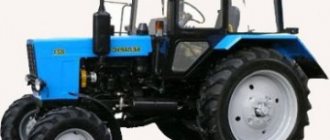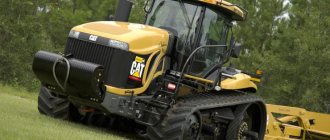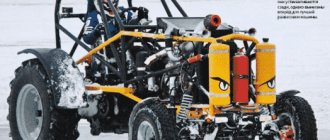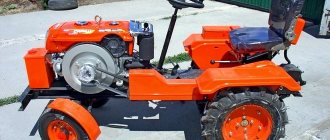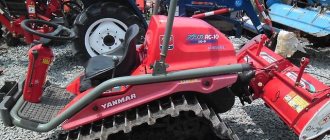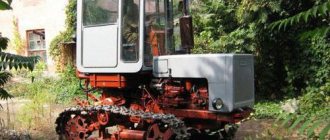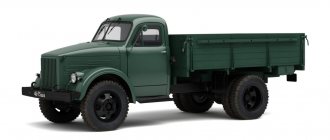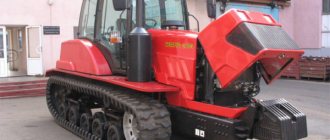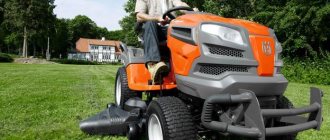The DT-75 tracked tractor, which was produced at the Volgograd Tractor Plant since 1963, at one time became the most popular in the USSR. It gained real popularity and people's love due to its functionality, ease of maintenance and repair, and low cost compared to other tractors of the same class.
The basic tractor model provided a surprisingly variable basis for the creativity of design engineers. Listening to the needs of rural workers, designers invented new modifications of the DT-75 tractor - for working in specific conditions (in swamps, on slopes, etc.).
Machine operators appreciated and appreciate the DT-75 tractor for its quality and simplicity. “Simple as a shovel,” is how they lovingly call him. And this is a real compliment, because for a village worker, simplicity means convenience, saving time, and the ability to make repairs yourself.
The DT-75 tractor, designed for universal agricultural work, belongs to the third traction class. A successful combination of performance qualities (versatility, simplicity, maintainability, cost-effectiveness) made this machine incredibly popular in the Soviet Union, and the powerful potential inherent in the design solution made it possible to create many modifications based on the first model. The next modernized model rolled off the assembly line in 2009. The appearance, the main components (engine engine, gearbox, transmission), and a number of other parts have changed.
In the beginning there was DT-56
At the end of the 1950s, the Soviet government began to think about the need to produce a new, progressive model of a caterpillar tractor that would meet the times and agricultural requirements. The task was entrusted to STZ.
It was planned that by the 30th anniversary of the plant (in 1960), the design would have already been developed, prototypes of the new tractor would have been produced, and state tests would have been carried out. And the work began to boil! But the DT-56 tractor model developed in 1957-1958 did not pass the test, and the tractor was not recommended for mass production.
Breakdowns and their elimination
Driving over rough terrain requires the use of low speeds. Otherwise, the box fails too quickly, and the box's movement is muffled.
In the following cases, you cannot do without repairing the box:
- The appearance of an oil leak.
- Lever travel is too loose and increased.
- When changing gears, difficulties and certain delays appear.
- The appearance of extraneous sounds. The probable cause is gear wear.
- The noise is coming from the box itself. Especially when moving equipment.
The service life of the box can be reduced both with insufficient oil and with its excess. The oil meter marks will help with timely measurement of the fluid level.
Too much fluid causes the system to overheat and leaks to appear. Usually the latter effect occurs if the sealing materials cease to be elastic.
Changing the fluid assumes a fully warmed-up power plant. Thanks to this, the fluidity of the composition improves. There is a special hole inside for draining. It is closed with a stopper. It needs to be cleaned of various contaminants before being put back into place. Only at the next stage is fresh fuel added. The main thing is to choose a liquid that can maintain its original properties at any temperature range.
Wear of the internal elements of the gearbox leads to the appearance of various noises. Engine overloads and high loads are the main causes of mechanical damage.
Additional repair recommendations
When disassembling gearboxes, it is recommended to use special stands. Pullers and personal tools become irreplaceable assistants. If possible, the main usable parts should not be disassembled. A complete disassembly is required only if a major overhaul is being carried out.
Here are just some of the main defects that are most often encountered in practice:
- The appearance of cracks and fractures.
- Wear of bearing seats.
- Damage to threaded, smooth holes.
The gearbox housing is discarded when emergency fractures appear that cannot be easily eliminated.
One option for eliminating cracks is to use arc welding. For work, special arc rollers or electrodes are used. Kerosene is a substance that allows you to check the tightness after the work is completed. To do this, weld seams are rubbed using chalk. Only the wall inside the device is wetted with kerosene. If seams appear, some kind of composite insulating material is applied to them. Thanks to this, the transmission of the DT 75 tractor lasts much longer.
When restoring seats, it is also allowed to use different methods:
- Banding.
- Polymer coatings.
- Galvanic coatings.
There are other options, but they deserve separate consideration.
Taking into account additional nuances
If the input shaft or axle is bent, then they are processed using a special press, in a cold state. With a few extra efforts, owners will increase the accuracy of their work.
Seats for bearings and shafts also require the use of several techniques:
- Arc surfacing.
- When metal strips are boiled.
- Ironing.
- Application of polymer-based materials.
During restoration, many parts require first heating to a certain temperature, and then cooling. Pressing helps to achieve certain sizes of holes and parts themselves, when necessary.
Even inside the gears, only a part can be replaced if it has the most serious wear, while the remaining indicators remain within normal limits. They simply remove the part with the most wear, since it would be impractical to get rid of the entire structure. The new ring gear is made using the same steel as the original part. After this the connection is made.
Shift levers and forks are more likely to bend, suffer from cracks, break, and wear out. Emergency breakdowns lead to the need to get rid of the entire part.
Make way for DT-75!
The next attempt, the DT-75 model, developed by a team of designers under the leadership of Mikhail Aleksandrovich Sharov, turned out to be successful. On July 16, 1959, the assembly of two samples of the new machine was completed, the technical and economic council of the Stalingrad Economic Council reviewed the project and recommended the DT-75 tractor for mass production in the event of successful tests.
At the end of 1959 and in the first quarter of 1960, the plant produced 22 DT-75 tractors, of which 17 were sent for state tests. During the season, tractors worked for 1500-2000 hours under load. Test data indicated the undeniable advantages of the new model compared to its predecessor.
The DT-75 tractor was 300 kg lighter, its speed increased by 35-47%, and its productivity increased by 28-38%. In terms of basic technical indicators, the DT-75 was superior to the best foreign tracked tractors.
Possible faults
Most often, malfunctions in the chassis and gearbox occur due to improper operation, as well as untimely maintenance. Otherwise, the DT 75 transmission is very reliable, its service life is comparable to that of the engine. Gearbox failure is accompanied by the following symptoms:
- increased noise while driving;
- metallic knock (wear of bushings or gear pairs);
- difficulty shifting or inability to engage the desired gear;
- long travel of the gearshift knob;
- oil leaking from under the cap.
The most common cause of gearbox failure on DT 75 is a critical drop in the oil level inside. This leads to overheating and accelerated wear in areas of friction of gears and roller bearings on the shafts. The oil level is checked regularly through special eyes in the housing. Despite the fact that the design of the gearbox includes special cups near the seals that prevent leakage, oil can be wasted or seep through other seals.
The wear of metal parts inside the box itself has its own patterns. First of all, the gears of the first and second gears, the support bearings of the input shaft, and the gear shift forks fail. The splined joints on the shafts are also subject to wear. A large gap in working components leads to an increase in the load on the part and contributes to rapid breakdown.
Troubleshooting gearboxes
Repair of the DT 75 gearbox should be carried out in a workshop or special service. To remove and disassemble the gearbox, you will need lifting equipment, special pullers and tools. During the troubleshooting process, components are discovered that require replacement, and parts or seats that can be restored. The design of the DT 75 tractor allows the following operations to be carried out during repairs:
- banding;
- galvanic and polymer coatings;
- welding;
- arc surfacing;
- forging and pressing.
For example, gear wheels are made dismountable, so during the repair process the ring gear is replaced separately from the supporting part. This saves money and simplifies all repairs. Bent shafts can be straightened in a press followed by annealing in an oven, etc.
The long way to the arable land and triumph
In 1960, the government decided to put the DT-75 tracked tractor into production at VgTZ. It took reconstruction of the plant and time to prepare the necessary facilities and equipment. While production was being prepared for the new model, they began to produce a transitional version - the DT-54V tractor. Its design made it possible, without stopping production, to replace the cabin, hydraulic system, suspension and other components with new ones and bring the design as close as possible to the DT-75 tractor.
At the end of July 1962, the first train of tractors of the new brand passed through the fields of the Saratov, Rostov, Volgograd regions and Stavropol Territory. The final transition to the production of DT-75 tractors occurred on December 30, 1963. On this day, a tractor with a scarlet pennant triumphantly rolled off the assembly line: “The last DT-54 tractor,” followed by a new red tractor with a pennant: “The first-born of assembly on the main conveyor.” Thus began the history of the legendary DT-75.
The pace of production of the new tractor was rapidly increasing. Already in the tenth month of production of DT-75 tractors, the level of production of old machines that had been developing over 14 years was reached. New enterprises appeared on the basis of the tractor plant: a starting engine plant in Mikhailovka, a motor plant in Razgulyaevka, a spare parts plant in Kotelnikovo and Frolovo, and a tool plant in Volgograd.
Since 1965, DT-75 tractors began to be exported, which raised the authority of the Soviet tractor industry and contributed to the development of agriculture in friendly countries. Deliveries were made to Poland, Bulgaria, Yugoslavia, Czechoslovakia, Cuba and a number of African countries.
Repair
In addition to major and medium-sized repairs, you have to deal with urgent repairs that are required as a result of a breakdown.
Bad symptoms are the following:
- Extraneous noise in the transmission that occurs during the startup of the DT-75 and its operation. Usually it is not difficult to recognize even against the background of the usual hum.
- Coolant leaks. They can be identified by a superficial inspection - even small leaks indicate problems with the seal.
- DT-75 slipping or unexpected jerks while driving.
- Not the final completion of processes after control action.
All this is an urgent indication for repairs, and the sooner this happens, the less costs it will cost.
When replacing transmission parts, it is advisable to use new original spare parts. They are well designed in terms of functionality and reliability. Sold as individual parts and assemblies. The decision about what can be left and what is better to replace should preferably be left to a specialist.
The DT-75 transmission is highly reliable and survivable in the most difficult conditions.
- Chassis DT-75
- Starting motor gearbox DT-75
- DT-75 controls: classification by purpose
Basic model DT-75
Initially, the tractor was equipped with an all-metal cab of a closed automobile type, unified with the cab of the GAZ-51 car. The seat was adjusted according to the weight and height of the driver. The modern DT-75 tractor also has a completely sealed cabin, protected from vibration and noise. There is an air duct for heating and a fan for cooling the air.
Initially, the tractor was equipped with a four-cylinder, four-stroke diesel engine SMD-14 liquid-cooled from the Kharkov Motor Company. The engine was covered on all sides by the hood from moisture and dirt.
The gearbox is mechanical, four-way, has seven gears and reverse. A planetary rotary mechanism is built into the rear axle, and the entire structure, together with the gearbox, is assembled in a single cast body, which made it possible to make a more rigid frame and ensure the transmission operates in cleaner conditions.
A special mechanism is introduced into the transmission - a torque converter, which makes it easier to start the tractor from a standstill and makes it possible to overcome temporary additional resistance by reducing the speed without stopping the tractor.
Reverse device
The most interesting thing about the VAZ 2114 roof rack
Structurally, the reverse gearbox contains not only toothed bevel gears that allow you to change the angular speed of the gearbox drive shaft, but also a reverse mechanism that determines the direction of rotation.
The drive gear, connected to the shaft coming from the clutch, is in mesh with a pair of driven gears mounted on the shaft of the tractor's manual transmission. The direction in which rotation occurs is controlled by a clutch installed between the gears and providing connection to one of them. This fairly simple design shows high efficiency and reliability. In the absence of mechanical breakdowns, this mechanism will work in any conditions, flawlessly performing its assigned function.
Control is carried out using a special reverse lever. Next to it are the necessary tips designed to help avoid doubts and mistakes. There is nothing complicated about this - it is much more difficult and important to understand why which gear is needed and choose it correctly. Errors in this matter can lead to ineffective operation of tractor equipment or even the inability to perform work.
"Construction code"
The first DT-75 tractors now look like mastodons, antique rarities.
However, the merit of the designers is that during the development of the tractor they managed to create a certain “design code” that provided the DT-75 family of tractors with such a long life and set the direction for all subsequent modifications. The main idea behind the development of the first DT-75 model was to create a simple, maintainable, economical agricultural machine. It was a success. During production, the DT-75 tractor repeatedly changed its design, was supplemented with new functionality and was made in many modifications. However, the main technical solutions applied back in 1963 still remain relevant.
Failures due to breakdown
Due to the fairly simple reverse device, DT-75 owners do not always pay the necessary attention to it. Meanwhile, this unit also needs periodic inspection and diagnostics for potential breakdowns.
The user is required to periodically monitor the level of transmission oil, which is poured directly into the housing and tends to leak or deteriorate its characteristics over time. For checking, a special probe is provided, which is part of the plug. It is advisable to do this not immediately after work, when the coolant may have a high heating temperature. Untimely replacement of tractor oil in the DT-75 reverse can have very unpleasant consequences in the form of its failure and a critical reduction in service life.
Symptoms of breakdowns are as follows:
- Lack of reliable grip. You don’t need to be an experienced mechanic to understand that the tractor has not switched to the desired gear or has not changed direction.
- Grinding noise during switching or operation.
Most likely, this means mechanical damage that will not go away on its own and requires repairs.
The reverse is quite difficult to fix on your own, and it is better to turn to professionals who will carry out more complex diagnostics and determine the extent of the damage. Restoring parts in this case is extremely rare - it is better to find replacement components that are guaranteed to have high properties and be covered by a warranty. The catalog of tractor spare parts for the reverse gearbox contains dozens of items, and you need to choose exactly what you had. When choosing, you need to take into account the modification of DT-75 - different models have their differences.
Reverse DT-75 requires original spare parts identical to those installed on the assembly line. To be sure of this, you need to choose reliable suppliers and not deal with cheaper offers of dubious quality.
Through swamps and hills...
Based on the base model, in 1964 modifications of the DT-75 tractor were made, adapted for work in special conditions: DT-75B (swamp) and DT-75K (steep). The design features of the swamp tractor are an increased support surface of the track chains and the ability to lower the guide wheels. Thus, it was possible to achieve increased cross-country ability in swampy areas (in the USSR, the tractor was in demand in the Baltic states).
A steep-slope tractor with the ability to work on slopes up to 20 degrees has made a real revolution in mountain farming! Thanks to redundant controls and two linkage mechanisms (front and rear), it could work without turning at the end of the site, cultivating the ground across the slope, horizontally.
With the help of the DT-75K, it became possible to expand the sown area, revive culled pastures, and cultivate fields of any configuration. And all this with low fuel consumption. This tractor was very useful in Transcaucasia.
Another well-known modification is the powerful, energy-rich high-speed tractor DT-75S, which VgTZ workers called “Volzhanin”. For the first time in the domestic tractor industry, it used an automated hydromechanical transmission and a torque converter, which made it possible to avoid an increase in the weight and dimensions of the machine. By January 1976, “Volzhanin” successfully passed economic and government tests.
Modifications of the DT-75 tractor with a fuel tank located on the side of the cab were aptly nicknamed “postman” by the people. These are tractors DT-75V and its swamp modification DT-75BV, DT-75M and DT-75MV, DT-75N and its swamp modification DT-75NV, DT-75D and its peat modification DT-75DT, DT-75RM.
Specifications
Technical characteristics of the main modifications of the DT-75 tractor:
| Modification | DT-75 | DT-75M | DT-75N | DT-75D |
| Tractor type | crawler, general purpose | |||
| Nominal traction force, kgf | 3000 | |||
| Tractor weight, kg*: | ||||
| - constructive | 5550-6050 | 6170-6740 | 5830-6400 | |
| - operational | 5840-6360 | 6640-7210 | 6330-6900 | 6295 |
| Length: | ||||
| - with hanging system | 4573,5 | 4670 | 4607 | |
| - without hanging system | 4109,5 | 4209 | 4240 | |
| - in transport position | 4380 | 4380 | ||
| Width | 1740 | 1890 | 1890 | |
| Height | 2304 | 2650 | 2650 | |
| Ground clearance, mm | 326 | 376 | 290 | 300 |
| Smallest turning radius, mm | 2250 | |||
| Base (distance between outer rollers), mm | 1612 | |||
| Track width, mm | 1330 | |||
| Track width, mm | 390 | |||
| Specific ground pressure, kgf/cm2 | 0,44 | 0,51 | 0,49 | 0,42 |
| Angles of descent and ascent, degrees | 20 | |||
| Static lateral stability, degrees | 40 | |||
| Max. steepness of the slope when the tractor operates across the slope, degrees. | 15 | |||
| Number of forward gears: | ||||
| - basic | 7 | 7 | 7 | 7 |
| — with the speed reducer turned on | 16 | 16 | 23 | |
| — with included RCM | 7 | 7 | ||
| - with reverse gear included | 7 | 7 | ||
| Number before reverse: | ||||
| - basic | 1 | 1 | 1 | 1 |
| — with the speed reducer turned on | 4 | 4 | 5 | |
| — with included RCM | 1 | 1 | ||
| - with reverse gear included | 7 | 1 | ||
| Speed range, km/h: | ||||
| - forward | 5,15-10,85 | 5,30-11,18 | 5,45-11,49 | |
| — forward with the remote control switched on | 4,12-8,68 | 4,24-8,94 | ||
| - back | 4,41 | 4,54 | 4,67 | |
| — back with the remote control switched on | 3,53 | 3,63 | ||
| — with creeper, forward | 0,33-4,74 | 0,337-4,886 | 0,34-11,49 | |
| — with reverse gear forward | 3,26-6,88 | 5,45-9,3 | ||
| — with reverse gearbox back | 4,05-8,54 | |||
| Fuel tank capacity, l | 245 | 315 | 315 | 315 |
| Engine make | SMD-14 | A-41 | SMD-18N | A-41I |
| Rated operating power, hp (kW) | 75 | 90 (66,2) | 95 (70,0) | 94 (69) |
| Maximum torque, Nm | 60 | 433 | 437 | 433 |
| Rotation speed, rpm: | ||||
| - crankshaft | 1700 | 1750 | 1800 | 1750 |
| — PTO | 536 | 553 | 540 and 1000 | 540 and 1000 |
| Corrective torque reserve factor, % | 15 | 15 | 12 | 15 |
| Nominal traction forces, kN: | ||||
| - main | 30-11,1 | 35,4-18,8 | 36,5-14,3 | |
| — with included RCM | 37,4-33,1 | 44,3-39,1 | ||
| — with reverse gear included (forward/backward) | 62,89/49,02-26,43-20,63 | |||
| Traction force during long-term operation with the UVK, speed reducer or reverse gear on, kgf | no more than 3500 | |||
| Number of cylinders | 4 | 4 | 4 | 4 |
| Engine displacement, l | 6,33 | 7,43 | 6,33 | 7,43 |
| Cylinder diameter, mm | 120 | 130 | 120 | 130 |
| Piston stroke, mm | 140 | |||
| Compression ratio | 17 | 16 | 16,5 | |
| Specific diesel consumption, g/l. s.ch. (g/kWh) | 195 | 185 (251,3) | 185 (251,3) | 166,9 (226,6) |
| Operating engine oil consumption from fuel consumption, %: | 3 | 1,5 | 1,5 | |
| - general | ||||
| - out of the blue | 0,8 | 0,7 | 0,4 | |
| Engine weight, kg | 720 | 930 | 960 | |
* – depending on the configuration.
Evolution continues
From 1968 to 1992, the tractor was produced at the Pavlodar Tractor Plant; in 2009, the baton was continued by the Volgograd Tractor Company, created as a result of the merger of the TsOP and TsMS VgTZ at the facilities of the Volgogradstroymash enterprise.
Since August 2009, a new modernized model with the trade name “AGROMASH 90TG” has been produced. Changes: the tractor's signature color has changed from red to blue and white with orange accents; increased volume cabin; increased fuel tank volume (from 260 l to 300 l); plastic hood; tinted double-glazed windows; new economical and environmentally friendly Finnish Sisu engine; higher operating weight; all hydraulic boosters were replaced with pneumatic boosters; additional attachments appeared - a snow blower and a pipe layer.
Thus, high-quality domestic technology, the design solution of which initially contained enormous potential, continues to develop.
Subscribe to our Telegram channel
Tractor engine
Chassis of the VAZ The 90-horsepower A-41I diesel engine was used for the first time as a power unit in the tractor. Subsequently, agricultural machines also began to be equipped with D-245.552 units, which are equipped with various modifications of trucks and special equipment. There are differences between these units:
- A-41I produces 94 l/s at 69 kW;
- D-245 – 95.2 l/s at 70 kW.
The engines are in-line, the tractor crankshaft rotates at 1750 rpm for the A-41I, at 1800 rpm for the D-245.
Tractor engines are powered by diesel fuel: a fuel tank with a capacity expanded to 315 liters is mounted on board the tractor, meeting the power needs of the powerful power unit.
The volume of the A-41I is an impressive 7.43 liters. The newer four-stroke diesel D-245 is less “voluminous”, only 4.75 liters, which gives the tractor visible savings on expensive diesel fuel.
Cabin
The first samples of the DT-75 could hardly boast of the comfort and technical equipment of the cabin. Later, in the DT-75M it became more convenient, like a car. The viewing angle has increased significantly by shifting the frame axis to the right. Front and rear windshield wipers guarantee good visibility and can even remove ice. A glass washer is also installed.
Cabin interior DT-75M
The new sprung cabin has become noticeably higher. Consumers became so accustomed to the old design that they began to write complaints to the plant, because after modernization the equipment no longer passed under trees. As a result, the original performance was restored.
The DT-75M crawler tractor is designed to operate in harsh weather conditions. Therefore, heating equipment is installed in the cabin for heating. For driver comfort, the cabin is equipped with a ventilation system that cleans the air from dust. Additionally, it is cooled and humidified. Switching on occurs automatically after closing the door and window openings. To maintain a microclimate, the cabin is insulated from noise and dust.
